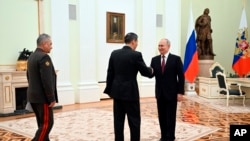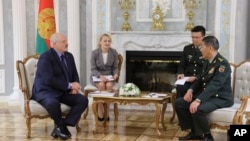Chinese Defense Minister Li Shangfu visited Russia and Belarus this past week in a show of support as the West seeks to isolate the two for Russia’s invasion of Ukraine. The U.S. sanctioned Li in 2018 for China’s purchases of Russian weapons.
On August 15, China’s state-run newspaper the Global Times, citing Russia’s Sputnik news agency, quoted Li praising the Sino-Russian military cooperation as open, transparent and conducive to peace and stability:
“[T]he two countries' military relations have set a model in non-alignment, non-confrontational cooperation that does not target any third party.”
That is false.
China and Russia are aligning their foreign policies and military strategies to undermine the Western-led liberal-democratic world order. Given that Russia invaded Ukraine in 2022 and China is eyeing Taiwan, their alignment is confrontational and targets third parties.
The Center for Naval Analyses (CNA), a U.S. government-funded defense think tank based in Arlington, Virginia, noted in May that China’s and Russia’s security interests have been increasingly overlapping for some time.
“The Putin-Xi February 2022 joint statement, made just before Russia’s invasion of Ukraine, demonstrated an increase in overlap in the two sides’ security concerns, with both leaders focusing on the threat posed by the United States and NATO to international security in general and to their own countries in particular,” CNA reported.
During Li’s first visit to Russia this past April, the two countries issued a statement vowing to take military cooperation “to a new level.”
Li met with Belarusian President Aleksandr Lukashenko on August 17. The Global Times reported that during their meeting, Lukashenko said military cooperation between Beijing and Minsk “is not intended to target any third country.”
Ukraine
Contrary to Li’s claim that China and Russia “have set a model in non-alignment, non-confrontational cooperation that does not target any third party,” the two countries are backing each other’s military moves against third countries.
Russia invaded and illegally annexed the Crimean Peninsula from Ukraine in 2014, and then launched a full-scale invasion of Ukraine on February 24, 2022.
Citing unnamed U.S. officials, various media outlets reported last week that nearly half a million Ukrainian and Russian troops have been killed or wounded since Russia launched its invasion.
More than 11 million Ukrainians have been displaced, according to the U.N. Refugee Agency (UNHCR).
While Russia’s invasion of Ukraine has met with international condemnation, China has refused to officially condemn Russia, insisting that “[d]ialogue and negotiation are the only viable solution to the Ukraine crisis.”
In February, the Stimson Center, a Washington D.C. think tank, described China’s strategy as “pro-Russia neutrality,” meaning Beijing is not actively taking a side in the Ukraine conflict, but is clearly pro-Russian in its rhetoric and propaganda.
Still, the BBC last March quoted Maria Shagina, an expert in economic sanctions at the U.K.‘s International Institute of Strategic Studies, as saying that China was exploiting the “gray space” between military and civilian purposes by sending high-tech products, including semiconductors, to support Moscow in its war effort.
Earlier this month, Politico reported that China “is pushing right up to a red line in delivering enough nonlethal, but militarily useful, equipment to Russia to have a material impact on President Vladimir Putin’s 17-month-old war on Ukraine.”
Politico added:
“The protective gear would be sufficient to equip many of the men mobilized by Russia since the invasion. Then there are drones that can be used to direct artillery fire or drop grenades, and thermal optical sights to target the enemy at night.”
A declassified report by the U.S. Office of the Director of National Intelligence in July concluded that support from China was “critical” to Russia’s ability to continue waging its war against Ukraine.
Taiwan
Meanwhile, it’s no secret that China has been eyeing neighboring Taiwan.
On August 19, Beijing launched military drills around the island after Taiwan’s Vice President William Lai stopped off in San Francisco and New York City as part of a visit to Paraguay.
The Associated Press reported that China’s Defense Ministry said the military drills were a “stern warning” over what it called collusion between “separatists and foreign forces.”
China sees Taiwan as a breakaway province and vows to eventually unify the island by any means. Taiwan has been governed independently since 1949, with the current administration favoring independence.
China’s leader Xi Jinping said in 2022 that China would strive for peaceful reunification, but would “never promise to give up the use of force and reserve the option to take all necessary measures."
China has been flexing its military muscle by conducting military drills around Taiwan, with the People’s Liberation Army sending fighter jets almost daily into Taiwan’s Air Defense Identification Zone (ADIZ).
In August 2022, the PLA held its largest military exercises around Taiwan in recent years after then-U.S. Speaker of the House of Representatives Nancy Pelosi visited the island.
China launched live-fire military exercises encircling Taiwan that lasted three days and included firing ballistic missiles over the island, some of which landed in the exclusive economic zones of Japan and the Philippines. The exercises were held much closer to the Taiwanese mainland then previous ones, with some of them reaching into Taiwan’s territorial waters.
In a joint Sino-Russian statement in March, Moscow said it “reaffirms its adherence to the one-China principle, recognizes Taiwan as an inalienable part of China's territory, opposes any form of Taiwan independence, and firmly supports measures taken by China to safeguard its sovereignty and territorial integrity.”







